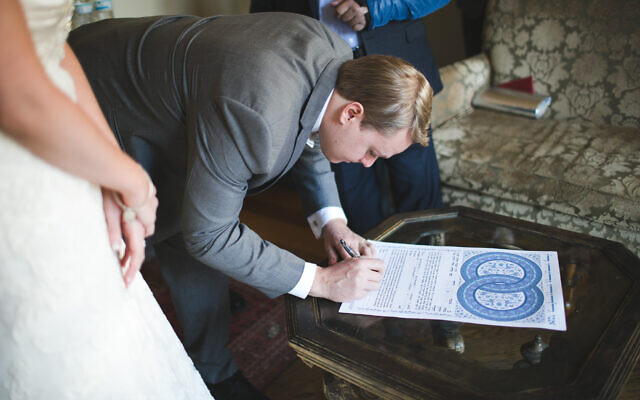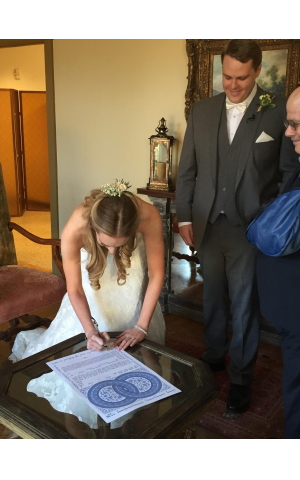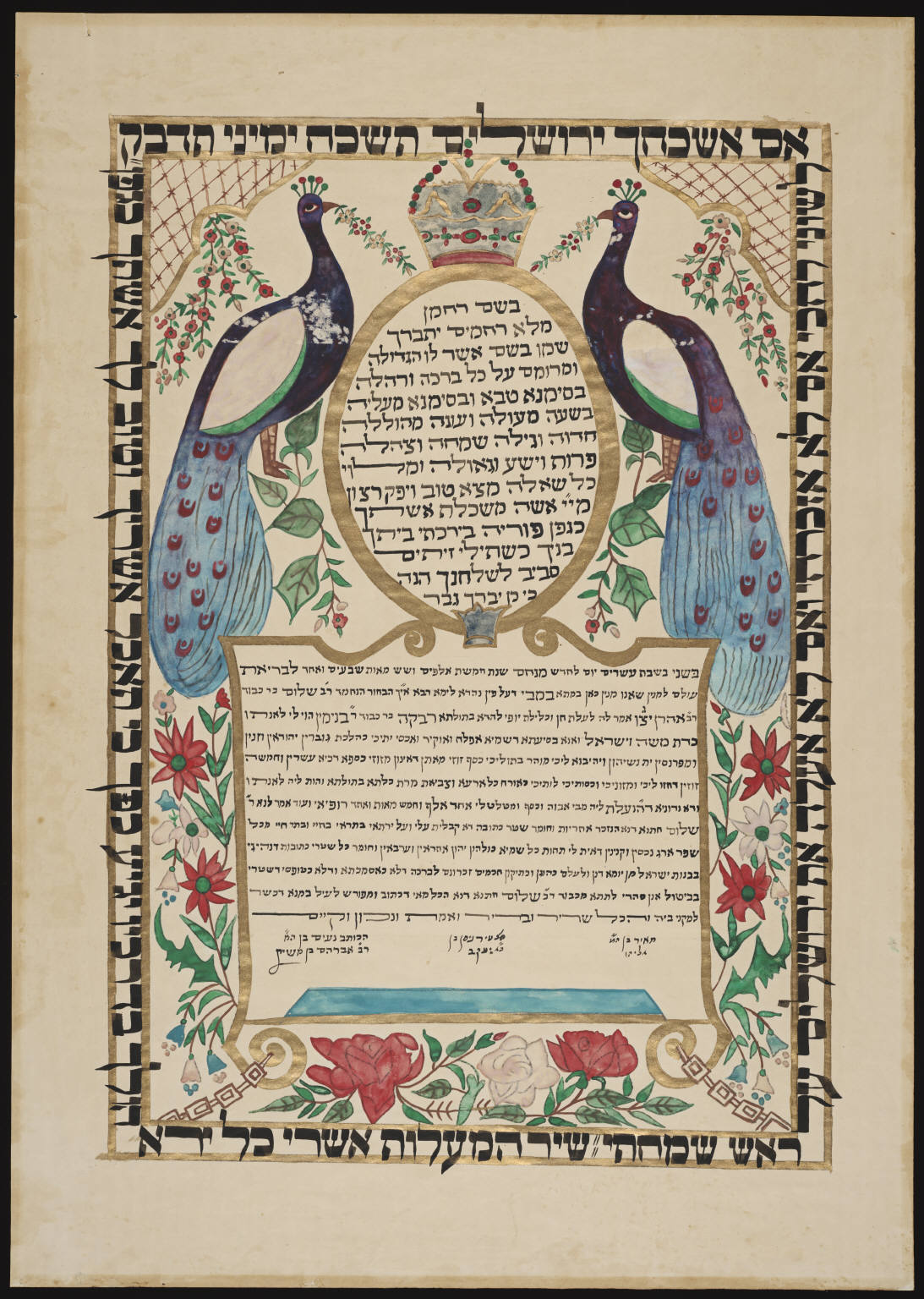The Ketubah: Ritual Contract of Love?
While the traditional document remains the standard at Jewish weddings, more liberal Jews have found ways to personalize the text, much like vows.

The text of the traditional ketubah marriage contract is anything but romantic, reminding married couples of the what-ifs common in the modern-day prenup. But most who stand under the chuppah these days very much in love see the ketubah as a symbolic and spiritual ritual to be honored as a standard Jewish wedding practice passed down through the generations much like the stomping of the glass, the unveiling and the exchanging of rings.
“The ketubah is an ancient traditional contract to remind a couple marrying of the prenuptial outcome,” said Rabbi Michael Broyde, an Emory University law professor known as an expert on Jewish law. “It basically outlines what happens when there’s a death or divorce.” It’s the agreement “that spells out what the wife is entitled to in the case of death or divorce. The ketubah comes from that model. For the last 1,000 years Jews don’t get divorced unless both parties agree.”
While the traditional document remains the standard at Jewish weddings, more liberal Jews have found ways to personalize the text, much like vows, and there is a recent move to make the text more egalitarian even among Conservative Jews and consider changing the text to make it more relevant to today.
To understand why some want to see the ketubah evolve, consider the meaning behind the standard Jewish pre-marriage contract.

Broyde summed up the basic content as: “how a husband and wife are to treat each other in a proper, meaningful way during marriage, each to conduct themselves as expected. If there’s a divorce, the husband pays the wife a fixed sum as a settlement. The ketubah governs the financial ending of the marriage.”
In fact, the traditional ketubah still calls for a husband to pay his wife “200 zuz and 200 zekukim of silver” upon dissolution of the marriage. It’s an ancient monetary system that has never been updated, said Broyde, who has written about the value and significance of the ketubah in America.
“It lost its basic premise. It’s much more ceremonial than legal. It becomes a ritual activity that commemorates the way things were.”
That’s why ketubot have become so focused on the artistry of the piece instead of the wording, Broyde said.
The Personal Touch
According to Ritualwell, a Reconstructing Judaism website, “Throughout the ages, ketubot have been illuminated and calligraphed, becoming significant as Jewish art. Today, all manner of egalitarian ketubot are written. Some dispense with the financial and legal aspects, focusing more on the emotional and spiritual sides of the relationship. Others maintain the rabbis’ concern with the practical, but define mutual obligations for each spouse.”
Reconstructionist Rabbi Malka Packer-Monroe is director of 18Doors Atlanta, a nonprofit that empowers and supports couples and families in interfaith relationships.
If they are not comfortable writing their own ketubah text, Packer-Monroe refers them to various resources such as ketubah.com for some standards, along with specialized ones for interfaith or humanistic couples, she said. They can buy from the site or change the text, in essence creating vows to hold each other responsible, she said. Some use the ketbuah as a basis and write additional vows.

Packer-Monroe challenges some of the practices associated with the 2,000-year-old ketubah. In the traditional “heteronormative” Jewish wedding, two witnesses to the ketubah need to be men age 13 and older, not related to the couple. “I work with couples who are egalitarian. As someone who does not strictly follow halachah (Jewish law), part of the ketubah process is finding people who will hold the couple to the statements they co-created, sometimes the wedding party, other times key people or their closest friends.”
She also has issues with the traditional ketubah text. “No one is acquiring another person as in the original ketubah text. At the time, ketubot were progressive. I call them the original pre-nup.” But 2,000 years later, the ketubah should reflect what the couple is like together, she said.
“I want to teach the history and value [of the ketubah] and how can we make it more meaningful. It’s how I see Reconstructionist Judaism. The past has a voice, not a veto. We look at the purpose and how we can make it reflect who we are today.”
Some questions she poses to couples about what to include in their ketubah: What do you hope marriage will be like? What do you want to hold in your heart? What things are difficult? What are you making a commitment to? “This gives room for more creativity,” she said.
“One couple not only wrote the text but created their own artwork.”
Packer-Monroe also encourages couples to read their ketubah text every year on their anniversary to remind themselves what they promised.
In all the weddings she’s officiated, only one chose not to have a ketubah, she said. “They think it’s a meaningful document, a piece of artwork. This is a document of their marriage that is publicly displayed in their home. I think a lot of people are interested in doing what’s been done traditionally in their family” even if they may not follow other family traditions. They tend to also break the glass and have some form of a chuppah, she said.

Equal Rights in Marriage
Recently, the Conservative movement’s Committee on Jewish Law and Standards approved new language for an egalitarian ketubah, according to committee member Rabbi Joshua Heller of Congregation B’nai Torah, a Conservative synagogue in Sandy Springs.
“The ketubah is a document that goes back well over 2,000 years. It was one of the first attempts to protect the rights of women in a male-dominated society,” he said.
But times have changed. Recent discussions have focused on having parallel language for the groom, Heller said. “Increasingly, couples are looking for language of the ketubah to reflect their own personal intentions as they enter the marriage.”

Many Conservative Jews will recommend Aramaic for the traditional ketubah, with additional language to offer greater protections for the bride in case of divorce, he said. Others will use a traditional ketubah and add a separate document, in English, with the increased protection. Others are more comfortable with egalitarian or more creative ketubot, Heller said. “When only one party is Jewish or parties are not a male and female, a lot of conversations might evolve.”
In Israel, a ketubah may specify more practical matters such as who pays for the apartment or who buys the car. “You see today’s couples exploring how much to customize based on their religious approach.”
Whether the resulting ketubot are “kosher” depends on who you consult, he said. Diverse streams of Judaism have different norms about what’s acceptable. “In the Orthodox world, the guard rails are very high. In Reform or Reconstructionist, there might be much more flexibility. Part of the diversity of Judaism is that there are very different approaches,” he said.
“What I usually counsel couples is: something old and something new. I encourage, if they’re using a traditional text in Aramaic, choose an English text that is more personalized. Choose language that reflects things you are bringing to your marriage.” In this way, the ketubah captures the spirit of their own relationship as well as the letter of the law, Heller said.
“The idea is that the traditional ketubah is a starting point instead of an end.” In other words, there are certain basic criteria that need to be met and the rest is personalized creativity to address the couple’s spiritual needs, he explained.
Revival in Sephardic Tradition

And then there are those returning to tradition, particularly in the Sephardic community. Rabbi Hayyim Kassorla, on sabbatical from Congregation Or VeShalom, said he’s seen an increase in requests for the traditional Sephardic ketubah.
Its first part mirrors the traditional ketubah with Aramaic, but more Hebrew names are mentioned than just the bride and groom, sometimes including two or three generations of a family, especially influential family members, Kassorla said. What makes it difficult to have a traditional Sephardic text is there are a lot of “interesting” abbreviations not all rabbis will be able to decipher that were intended to safeguard the modesty of the couple, he said. The abbreviations may stand for the beauty, intelligence or knowledge of the couple. The challenge is the rabbi needs to understand the language to accurately use the ketubah, Kassorla said.
“It has to be done tactfully and in the proper way or you have a document of no use; it has not really fulfilled the requirement of getting married with a ketubah.”
The second part of the Sephardic ketubah mentions what happens if the groom doesn’t honor his wife. It also sets out further stipulations for the groom: In some Sephardic ketubot, he cannot have another wife and cannot travel without his wife’s permission, Kassorla explained. It’s based on the enactments in Castile, Aragon and Granada in Spain. The ketubah also shows the creativity of Sephardic rabbis to offer more protections in the marriage for the woman, Kassorla said. “The rabbis felt it was the operative time to protect the bride.”
In addition to the two traditional witnesses, it was customary for almost everyone in the family to sign the ketubah as an act of honor, he said.
Generally, the ketubah is not hung on a wall in a Sephardic home, but kept in a place with important documents. “The rabbis were afraid if there was a difference of opinion, the man would steal it off the wall and claim they never married.”
The exception is among converts to Christianity, derogatively called Marranos, who displayed their artful ketubot in its secret language as an allegiance to their Jewish heritage in the face of persecution. Through the artistry, the creativity, as if a portrait or painting, it ensured the ketubah did not raise any concern about a Jewish connection, he said.
Instead of 200 zuz and 200 zekukim of silver, Sephardic raise denominations revolving around the number six, such as 666 or 6,666 to symbolize the sixth day of creation when the first bride and groom, Adam and Eve, were created, Kassorla said.
“It’s considered a significant honor to raise an amount to protect the bride.” Sometimes it’s not an amount, but a promise of real estate owned by family being given to the bride in case there’s a need or a husband passes away, to take care of her needs and rights.
“Rights and responsibilities are taken very seriously.”
Prenuptial Agreement
Traditional Jews have a prenuptial agreement separate from the ketubah to ensure the groom gives a get, Jewish divorce, and does not leave his wife agunah, literally chained, unable to remarry. The prenuptial is enforceable in a court of law, Kassorla said.
In Conservative circles, there’s a clause added to the ketubah to protect the wife in the same way.
In 1953, The Rabbinical Assembly and the Jewish Theological Seminary accepted an additional clause in the ketubah proposed by rabbi and Talmudic scholar Saul Lieberman, Ritualwell states. The purpose of the clause was to help solve the problem of agunot. “The bride and groom agree to recognize the authority of the Bet Din of the Rabbinical Assembly and the Jewish Theological Seminary to summon either party at the request of the other to enable the party so requesting to live in accordance with the Torah.”
In more recent years, there’s been a move to a separate document, the T’nai B’kiddushin (condition of the betrothal), ensuring neither bride nor groom hold up the other in a Jewish divorce, Heller said. The document also provides the grounds of a legal annulment, invalidating the wedding ceremony if either party doesn’t comply, he said.
The purpose: If you bring a ketubah into family court to force compliance with the marriage contract, it’s not likely to be successful, but a separate legal document with more powerful language might be more effective, Heller explained.
“The separate document is easier to enforce and more powerful and provides some more teeth to a couple who doesn’t comply.”
Of course, this type of document only applies for couples affiliated with the Conservative movement. Orthodox are stricter in their approach to the get, and Reform may not require a get for remarriage.
Secular prenuptial agreements have grown in popularity in the last 30 years, Broyde said. “With the secular divorce rate so high, it’s not ridiculous to ponder the possibility of divorce when you get married.”
So much for a romantic wedding tradition that’s been passed down generation to generation.




comments